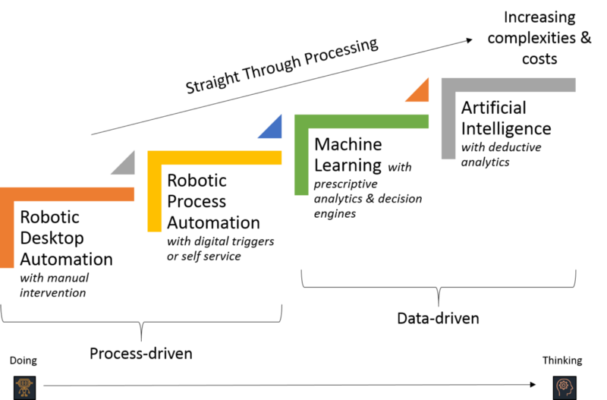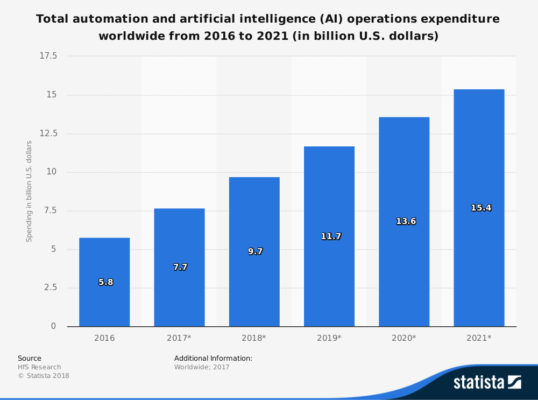“I see the movement towards AI and Robotics as evolutionary, in large part because it is such a sociological leap” (Geoff Livingston, Author, and President of Tenacity5 Media)
Considered as the cornerstone of digital transformation journey, intelligent automation is enthusiastically maturing into a whole new technological era. Up till the date, intelligent automation has mature to the point that it is targeting almost every sector of the economy. An undeniable fact says “the change is inevitable” and of course it is recognized by several major industries. This is the reason that they are constantly in search of adopting new technologies to drive the inefficiencies of out their organizations. Intelligent automation is simply working as the most effective way to do so and becoming a norm nowadays. Standing at an overall market worth of $108.0 million in 2017, what exactly is intelligent automation? Is it just another over-hyped topic or is it something that we should be taking notice of?
Breaking the term ‘Intelligent Automation’ is composed of two words
Intelligent; which refers to Artificial Intelligence
Automation; which refers to automation processes, the most famous of which is Robotic Process Automation.
So, basically Intelligent Automation is a happy marriage between Artificial Intelligence and RPA which achieves the advantages of automation bestowed by intelligence. Galloping hand in hand artificial intelligence and process automation can truly provide great benefits to the existing systems:
- Increasing the efficiency of processes
- Improving the customer’s experience
- Optimizing back-end office operations
- Reducing costs and risks
- Optimizing productivity of the work force
- Effective monitoring and providing fraud detection
- Products as well as services innovation
Having such a great impact on traditional manual processes, these two terms of AI and RPA are often confused to be the same, but they are not. RPA is basically a pre-configured software with business rules and activities, used for complete autonomous executions of business processes like retrieving emails, downloading attachments, creating bills and invoices, etc. On the other hand, AI works much in producing analytics and insights at human capabilities like read the invoices or extract information such as invoice number, supplier name or due amount.
In simple words, we can say that RPA mimics human actions and the process-driven part whereas AI is concerned with human intelligence and the data-driven part of the continuum known as intelligence automation.

The global market statistics of Intelligent Automation Market seems to be going off the charts, as by 2021 the expected market growth of Intelligent Automation will be reaching $2.9 billion. The total automation and AI operations expenditure will grow to $15.4 billion by 2021 as shown below:

“A lot of things will happen in automation in the next couple of years. RPA is just one tool in the toolbox. We will also use AI-based tools and process optimization techniques for automation in the financial market” (Jenny Dahlström, Head of Robotic Implementation for Handelsbanken Capital Markets)
According to a report by Capgemini, in organizations from across different segments, 64% of them have seen an improvement in customer satisfaction by more than 60% through Intelligent Automation.
Intelligent Automation conceals a lot of benefits within so it may sound like really simple and easy to implement but in reality, it requires extensive planning, several rigors and most importantly, identifying the right automation program for the right use case. Here are ten essentials points for the successful implementation of Automation Processes
- Initialize with a proof of concept
- The missionary people should be identified and brought on board
- The choice of processes for the entire program should be wise
- Expectations should be set right
- Identify and Explore tools for strengthening the automation implementation
- Automation requires business and IT to work in harmony so the value should be co-created
- The focus should always be on having a powerful solution
- Follow an iterative process for tuning your solution
- Always track savings on the baseline
- Adopt a holistic strategy and plan for the sustainability of your organization
Choosing RPA, AI or even both pretty much depends on the use case or the industry you are targeting but the bottom line is that, if your implementation is focused, clear and good you can carve the best results out of your organization through Intelligent Automation which can assist you for a long run success.

With a set of notable skills in ‘Computer Sciences’, Farzan Masood also holds a post-graduate degree in ‘Information Systems and Business Management’ making him able to work on both sides. Farzan has got his expertise in conducting various processes for achieving and ensuring enhanced quality work as a technical writer and researcher. From preparing proposals and whitepapers embedded with technical knowledge to creating high impact marketing content, Farzan is capable of writing words that inspire, encourage, educate and leave a positive impression on the readers of his work.





